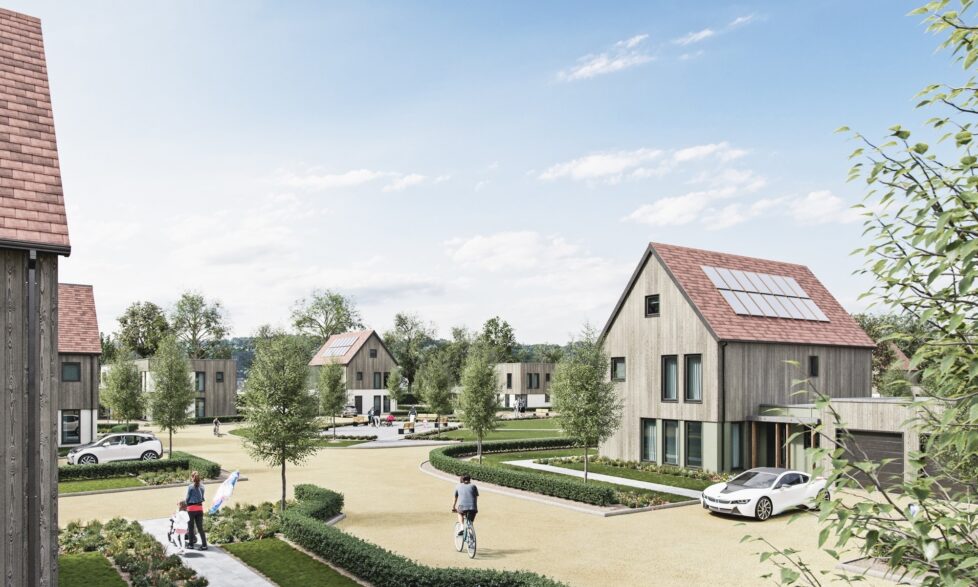Springfield Meadows is tackling the critical issue of upfront carbon emissions
With the Government’s new ‘net-zero’ target, much is being said about creating zero-carbon homes – this means building highly energy-efficient homes that run solely on renewable energy, generated both on and offsite.
But we shouldn’t forget about the carbon emissions created during the construction of homes. This is often known as ‘embodied carbon’ but as Lloyd Alter, editor of Treehugger, recently wrote: “it isn't embodied. It is in the atmosphere now.” So, I agree with him that these should be known as ‘upfront carbon emissions.’
And as we fight to meet our targets to tackle ecological and climate breakdown, this is just as urgent an issue because these upfront emissions will make up almost half of total new construction emissions between now and 2050.
Springfield Meadows is upfront about it
Which is why it’s been incredibly rewarding working for the last 12 months with the developer behind Springfield Meadows, a new zero-carbon, custom-build community in rural Oxfordshire, that is addressing this elephant in the room face-on. It has 16 plots for custom-built 2, 3, 4 and 5-bed homes with 9 affordable homes.
Russell, Ian and Clive and the wider team at Ssassy Property are collaborating with Greencore Construction to use a highly innovative construction technique and natural materials. This delivers highly energy-efficient and healthy buildings with a reduction of approximately 90% in upfront carbon emissions compared to a standard home in the UK.
Greencore builds homes using a timber frame and hemp-lime panels with wood fibre insulation, resulting in a much lower carbon footprint than traditional bricks and mortar. Wood and hemp both sequester – or absorb - carbon while growing, meaning it’s taken out of the atmosphere and ‘locked-in’ to the building.
This will save in the region of 250 tonnes of greenhouse gas emissions across the entire development site – equivalent to taking 50 cars off the road for a year.
Historically, using hemp-lime has been seen as messy and time-consuming as it takes a long time to dry. Greencore uses the Biond system, which avoids these issues by creating these panels offsite. The panels are factory-built and slot together easily - meaning faster building time and excellent energy performance with high airtightness levels. Hemp is also great at keeping homes warm and regulating humidity.
The result? Warm, comfortable homes that are cheap to heat and healthy to live in that can help us meet our net-zero goals.
A Global Leader in One Planet Living
And this pioneering community isn’t just showing leadership when it comes to upfront emissions. Using our sustainability framework One Planet Living, Springfield Meadows is designed to help residents lead happier and healthier lives with a very small carbon footprint, as well as engage with nature.
The homes are built to a Passivhaus standard and so will be low-carbon in operation, with solar PV panels, air-source heat pumps and a connection to a green electricity supplier. There is no gas supply.
Residents will also be able to enjoy seeing local nature thrive with a community orchard and wildflower meadow, as well as their own large gardens, a shared green space and herb garden.
The rural location makes sustainable travel trickier but, as it’s only 12 miles from Oxford city centre with excellent bus links, Ssassy Property is providing all residents with free bus passes for the first year. The developer is also investing in and promoting an onsite car club.
Springfield Meadows shows zero-carbon development can be done – why don’t you?
All of this is no mean feat when you consider Springfield Meadows is a small, rural development. It is creating a truly sustainable community – that starts by tackling upfront carbon emissions all the way through to enabling residents to live sustainable lives from day one.
Because of this commitment, Bioregional has recognised Springfield Meadows as a Global Leader in One Planet Living.
So, I will leave you with this challenge: Springfield Meadows highlights that we can build homes with minimal upfront carbon emissions, achieving net-zero carbon in operation (even on a smaller site) as well as enabling residents to enjoy a better, low-carbon quality of life.
If we are to stand a chance of tackling the climate and ecological emergency, surely all houses should be built this way?
Learn more about our sustainability framework One Planet Living and how we can help you achieve zero-carbon communities where people want to live.








